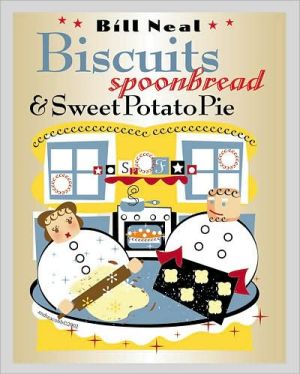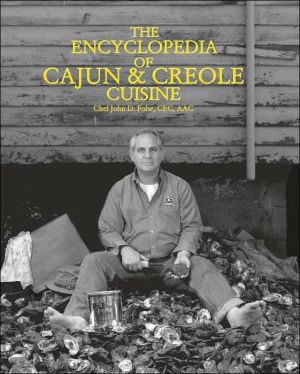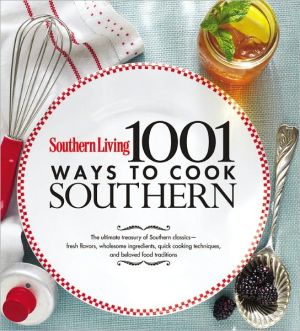Biscuits, Spoonbread, & Sweet Potato Pie
This delightful cookbook celebrates the glories of southern baking, with 300 recipes for the breads, biscuits, cakes, pies, cookies, and sweets that have been the pride of southern cooks for generations.\ From his first chapter on cornmeal—with recipes for dumplings, hushpuppies, and four styles of spoonbread—to his delicious array of desserts—including persimmon pudding, lemon chess pie, and pecan cake with caramel icing—Bill Neal interweaves fascinating bits of culinary history with a...
Search in google:
This delightful cookbook celebrates the glories of southern baking, with 300 recipes for the breads, biscuits, cakes, pies, cookies, and sweets that have been the pride of southern cooks for generations. From his first chapter on cornmeal--with recipes for dumplings, hushpuppies, and four styles of spoonbread--to his delicious array of desserts--including persimmon pudding, lemon chess pie, and pecan cake with caramel icing--Bill Neal interweaves fascinating bits of culinary history with a native's knowledge of the cooking secrets of the rural South. He demystifies beaten biscuits, revives such southern standbys as baps and bannocks, and freshens up old favorites such as peach cobbler and fruitcake. Passing on the traditions of the southern kitchen, Neal pays tribute to the richness of the region's heritage. Biscuits, Spoonbread, and Sweet Potato Pie was first published in 1990.
Biscuits, Spoonbread, and Sweet Potato Pie\ \ By Bill Neal \ The University of North Carolina Press\ Copyright © 2003 University of North Carolina Press\ All right reserved.\ ISBN: 978-0-8078-5474-7 \ \ \ \ Introduction\ This book of recipes is about the breads and sweets that have been the pride of Southern cooks for over three hundred years. It is for those cooks today, both Southern and non-Southern, who love the yeasty smell of rising dough, the on hands relationship with the foods they eat, the joy of finding the season's best produce in the market. It is a Southern trait to have a story for every occasion, and almost every recipe in this book has a little preface or explanation about how that dish is part of my life or part of the life of the region. When I cook, I am constantly telling my children something like "This is your grandmother's biscuit." I mean it isn't just something to fill up their stomachs; it's part of the way crafts, traditions, and cultures have been perpetuated for thousands of years-one generation teaching the next. Almost everyone has a special recipe from a grandmother or an aunt that means more than how it tastes. All the recipes of this book belong to that kind of heritage. They will belong to the future as we cook them and share them with those we love. \ I grew up eating the foods that an independent Southern farmer would have eaten one or even two hundred years ago: home-baked breads mostly of cornmeal, beans, and squashes of all sorts; lots of pork, both fresh and cured; fresh milk and butter. It was wonderful food-seasonal, plentiful, and mostly produced at home. We grew vegetables almost year-round, and even in the dead of winter there were spicy wild field cresses for a pot of greens. My grandparents kept livestock-pigs, milk cows, mules for plowing, and chickens that scratched the earth, ate corn, and gave eggs with yolks as brilliant as a setting sun. It seemed as if our whole world was about food: growing, gathering, and preparing it. Almost everything that went onto our table had the input of three generations' work and care. I am amazed today when I think of the array of fruits and berries that we picked as children. Blackberries from neglected pastures; wild plums, persimmons, and muscadines from the woods; cherries, peaches, and apples from our small orchard and pears from the neighbors'; and figs from the tree that grew behind the smokehouse. It was a staggering harvest that didn't seem to daunt my mother or grandmothers. They turned out pies, cakes, cobblers, and ice creams almost daily from what we brought in. And the intense aromas of fruits reducing for jams and jellies were the perfume of the kitchen. It was a life as idyllic for children as it was tenuous and exhausting for adults.\ By the time I was six or so, that way of life began to disappear. My father turned to manufacturing for his income. We still kept a garden but no longer raised so much of our food. When I was about four, I earned my first quarter for hoeing my father's cotton. By the time I was twelve, much of that cotton field was under the asphalt of an interstate highway, and the rest of the field was the site of a factory producing synthetic fibers. Such changes have eroded the traditional rural life of the South for over one hundred years. Eudora Welty poignantly expressed this sense of loss in The Wanderers (1949).\ Later, back in the parlor, she cried. They said, "She used to set out yonder and sell muscadines, see out there? There's where she got rid of all her plums, the early and late, blackberries and dewberries, and the little peanuts you boil. Now the road goes the wrong way." Though that was like a sad song, it was not true: the road still went the same, from Morgana to McLain, from Morgana to Vicksburg and Jackson, of course. Only now the wrong people went by on it. They were all riding trucks, very fast or heavily loaded, and carrying blades and chains, to chop and haul the trees to mill. They were not eaters of muscadines, and did not stop to pass words on the season and what grew. And the vines had dried. She wept because they could not tell it right, and they didn't press for her reasons.\ The sad theme of loss runs through all of Southern culture from way back. The black spirituals and blues are its musical expression. But its countertheme is endurance. Today, Southerners are more and more aware of their traditional foods as the rest of their culture blends into that of the nation as a whole. Certain dishes give identity to entire communities. Yearly, thousands of people flock to small towns all over the South for festivals in honor of such lowly foodstuffs as chitlins, ramps, and collards. A few years ago, most Southerners wouldn't admit to still eating these foods. Now we see bumper stickers directing us to "Eat more possum." It isn't just a joke. We know we are Southerners because we do eat possum and grits and okra. When we no longer eat these foods, we no longer will be Southerners. Our diet reflects the history of the region and its people: Native Americans, Europeans, and Africans. Our food tells us where we came from and who we have become.\ All Southerners, Indian and black and white, have shared the basic diet of beans and corn. It is the original diet of this hemisphere, the core of Southern as well as Caribbean and Central American cooking. When outsiders ask "What is Southern cooking?" I think they don't look far south enough for the answers. Our style is more similar to Mexican than to European cooking. I can't imagine a Southern kitchen without cornmeal, and our breads begin with it.\ Many of our dishes are European. Some passed directly into the tradition with little or no change. Wine jellies, trifles, and fruitcakes are scarcely distinguishable from their eighteenth-century British ancestors. Other European techniques are adapted to native ingredients: French tortes made with the native pecans, crumpets made with grits, custard pies thickened with cornmeal. This hybrid cooking is the most intriguing to me; it reveals the ingenuity and creativity of the Southern cook combining Old World practices and New World foods.\ The third major, and most exotic, influence is African. Our sweet potato biscuits, for example, are in the African tradition of using starchy tubers rather than milled cereal grains to make bread. The peoples of the West Indies and the South prepared their breads not only from yams, but from cassava, manioc, tanyah, and arrowroot. And they brought from their homelands techniques for working with sugar in a hot, humid climate which influenced the way we make candies and confections.\ The first published recipes that are recognizably Southern, incorporating these three cultural influences, come to us from three nineteenth-century books: The Virginia House-wife, The Kentucky Housewife, and The Carolina Housewife. Mary Randolph, who was of a distinguished family and a relation by marriage of Thomas Jefferson, published The Virginia Housewife in 1824. In her mid-forties, after losing a secure income, she opened a boarding house in Richmond, which was celebrated for its splendid meals. Mrs. Randolph's taste ran much to the Continental; her collection of recipes sometimes reminds me of Patrick Henry's remark about Mr. Jefferson: "[he] came home from France so Frenchified that he abjured his native victuals." Mrs. Lettice Bryan's The Kentucky Housewife (1839) is more down to earth. She knows the frontier and has practical instructions on open-fire cooking, as well as offering detailed descriptions for formal entertaining. Sarah Rutledge, sophisticated and rich, compiled the most important collection of Southern recipes we have, The Carolina Housewife (1847). Her recipes reflect the cooking of all levels of society, from the plantation foods to those directly from the African tradition. Many of her dishes have long since disappeared from the home kitchen, as is true of those of Mrs. Randolph's and Mrs. Bryan's, but without these three "housewives," a reconstruction of the historical cooking of the South would be sadly incomplete. When I don't have recipes drawn from my own experience, the three housewives provide a source and inspiration for recreating the cooking of yesterday.\ All this background may seem rather abstruse stuff if we forget that the origins of Southern cooking were dynamic, extemporaneous, and creative. One aspect of cooking-and an impetus to it I've not yet mentioned-is the force of hospitality in the South; here it is a moral obligation of the host to feed the guest. The tradition is ancient and echoes Homer in The Odyssey when Eumaios welcomes the unknown and shipwrecked Odysseus: "Strangers and beggars come from Zeus: a small gift, then, is friendly. Give our new guest some food and drink...." How much more do we owe those we love and who gather together at our table daily? I invite you to cook these recipes in that spirit and in the spirit in which they were first created, foods to nourish the heart and soul as well as the body.\ (Continues...)\ \ \ \ \ Excerpted from Biscuits, Spoonbread, and Sweet Potato Pie by Bill Neal Copyright © 2003 by University of North Carolina Press. Excerpted by permission.\ All rights reserved. No part of this excerpt may be reproduced or reprinted without permission in writing from the publisher.\ Excerpts are provided by Dial-A-Book Inc. solely for the personal use of visitors to this web site. \ \
\ \ \ Introduction\ \ \ \ \ Acknowledgments\ \ \ \ \ The Gift of Corn: Breads, Dumplings, Pancakes, and Fritters\ 1\ \ \ \ The Pride of the South: Hot Biscuits\ 37\ \ \ \ Mostly Breakfast Cakes\ 65\ \ \ \ Yeast-Risen Breads\ 77\ \ \ \ From Our British Heritage\ 101\ \ \ \ Rice, Rye, Whole-Wheat, and Oatmeal Breads\ 121\ \ \ \ Confections and Sauces\ 137\ \ \ \ Fruit Desserts\ 163\ \ \ \ Cooling Off: Frozen Desserts\ 195\ \ \ \ Delectables: Custards, Bavarians, Curds, Mousses, Jellies, and Puddings\ 225\ \ \ \ Cookies and Small Cakes\ 257\ \ \ \ Pies, Tarts, and Sweet Dumplings\ 289\ \ \ \ Home-Baked Cakes\ 319\ \ \ \ Select Bibliography\ 357\ \ \ \ Index\ 361\ \ \ \ Textual Acknowledgements\ 381\ \
\ From the PublisherAn authoritative journey through the baking and related confectionery cooking of the South. (New York Times Book Review)\ An invaluable collection of the breads and sweets of the South. . . . Neal is as much a food historian as a cook; writing in a readable, relaxed style, he manages to convey a vast amount of information on the origins of Southern baking. (Library Journal)\ \ \ \ \ \ Cookbook DigestNeal . . . was considered one of the nation's most talented young chefs. This book insures his influence on today's chefs and home cooks.\ \








